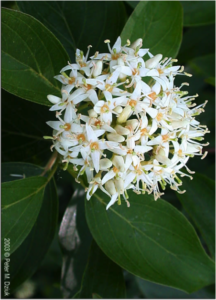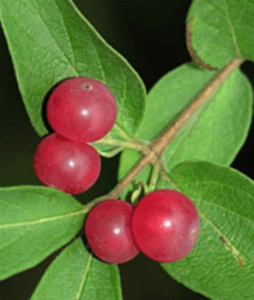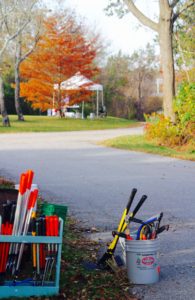Why Favor Native Plants over Non-Native Plants?
In 2015, Jamestown’s Town Council approved the TPRA’s approach to restoring Taylor Point. Simply stated, the approach was, and is, to “…create and maintain a Taylor Point Natural Area that prioritizes habitat protection and improvement …”
The first stated goal TPRA put forth in support of this approach was to:
“Restore the Taylor Point habitat with native species that will maximize the ecological value of the 20± acres of undeveloped land at Taylor Point. Remove all non-native vegetation, nurture existing native species, and plant new natives where needed.”
Thus, TPRA’s first targeted mission, ahead of improving footpaths, or reinforcing shoreline erosion control and stabilization measures, or enhancing viewscapes, was to encourage native plants and eliminate non-native plants. Consistent with the recommendations of conservation biologists, ecologists, and land managers all over our region and all over our nation, TPRA called for a renewed emphasis on promoting and maintaining native species.


Why is this? What is behind this favoring of native over non-native species?
A casual observer passing by some of the Taylor Point woodlands might assume – after noting the dense thickets of overgrown invasive shrubs and vines dominating broad expanses of land and strangling and outcompeting the native plants – that the issue might be simply one of aesthetics. These overgrown areas simply look bad; messy, untended!
In fact, the issue is far more serious from an environmental standpoint, and it concerns:
the potential long-term ( and in some cases short-term ) viability of our native ecosystem assemblages of local birds, butterflies, pollinators, wildlife, etc. ;
the potential consequences of continued reductions in biodiversity throughout our region and the country;
the very survivability of desirable native plant, animal, bird and insect species; and
soil and land conservation.
Non-native species can overtake an area aggressively, changing local plant assemblages, reducing diversity, and upsetting the natural balance that once characterized an ecosystem. Natural balance achieved by an undisturbed ecosystem generally results from eons of evolutionary progression; a concomitant and parallel evolution of the plants and insects and birds and animals that existed locally through time and in close proximity. These local species have adapted to their native environmental conditions and also have adapted to each other such that they have grown dependent on each other for survival. This interdependence helps to maintain an overall balance of nature.
For example, without native plants and the insects that co-evolved with them, local birds may not be able to survive. Entomologist Doug Tallamy’s observations of the ecological dependence of native oaks, caterpillars, and song birds are often cited to illustrate the significance of the interconnectedness of native species in various levels of the food chain. Tallamy observed that native oak trees can support more that 500 caterpillar species. By contrast exotic ginkgo trees, often favored over oaks by homeowners and urban landscapers, host fewer than five caterpillar species.
Scientists assert that more than 6,000 caterpillars are required to raise one brood of chickadees. Chickadees will raise 1 – 2 broods each season. With 500 species of tasty caterpillars nearby, the likelihood that a sustainable food source will be available during the 2-3 week periods that each brood is being fed by the parents, is strong. Given only five caterpillar species, such as those associating with the ginkgo tree, the likelihood that sufficient food will be available to feed the young chickadees over this extended period of time is greatly diminished. If there are insufficient caterpillars to sustain the chickadee fledglings, the chickadees may die out.
Chickadees not only feed on caterpillars, they also feed on such pests as spruce budworms and cankerworms. Without the chickadees, these undesirable pests will lose a key predator. The spruce budworm is reputedly one of the most destructive native insects in the northern spruce and fir forests of the Eastern United States. Cankerworms also can cause significant defoliation of a variety of deciduous landscape and forest trees. And so the disruptions to the web of life may reverberate through the food chain with the loss of the chickadee.
Further, Tallamy asserts that in a majority of cases, native insects cannot, or will not, eat alien plants. Thus, when native plants disappear, the native insects disappear, a circumstance that in turn diminishes local food sources for birds and other animals. In the case of pollinators that depend on native flowers, their disappearance may lead to a rash of unfertilized flowering plants and the resulting reduction in local fruits and berries. The reduction in these natural resources can in turn affect the populations of migratory birds that rely on them during seasonal migrations, and so it goes.
 By encouraging the re-establishment of native species and by eliminating non-native species at Taylor Point, TPRA hopes to help restore the natural balance and ecological integrity and productivity of this shoreline habitat. By nurturing native plant species, we hope to stabilize native song bird, insect, and small mammal assemblages as well and hopefully promote the natural resilience that is borne of ecological balance. That is why promoting native species and reducing or eliminating non-native species is the cornerstone of our restoration efforts.
By encouraging the re-establishment of native species and by eliminating non-native species at Taylor Point, TPRA hopes to help restore the natural balance and ecological integrity and productivity of this shoreline habitat. By nurturing native plant species, we hope to stabilize native song bird, insect, and small mammal assemblages as well and hopefully promote the natural resilience that is borne of ecological balance. That is why promoting native species and reducing or eliminating non-native species is the cornerstone of our restoration efforts.
For information on native plants, and profiles of some of Jamestown’s ecologically significant and valuable native species read our Jamestown’s Native Plants: Why Protect Them? .
For more information and insight on why scientists and managers recommend encouraging native plants over non-native ones, please consult any of the following sources:
Additional References:
Invasive Plants: Guide to Identification and the Impacts and Control of Common North American Species, 2nd Edition by Sylvan Ramsey Kaufman and Kaufman, 2007.
Bringing Nature Home: How You Can Sustain Wildlife with Native Plants,
Douglas W. Tallamy (Author), Rick Darke (Foreword), April 1, 2009.
Newcomb’s Wildflower Guide, Lawrence Newcomb (Author), Gordon Morrison (Illustrator), April 13, 1989.